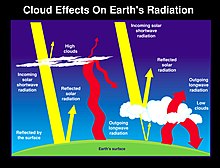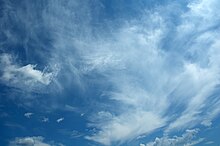20:
58:, accounting for approximately half of Earth's albedo. Cloud albedo is influenced by the conditions of cloud formation and variations in cloud albedo depend on the total mass of water, the size and shape of the droplets or particles and their distribution in space. Thick clouds reflect a large amount of incoming solar radiation, translating to a high albedo. Thin clouds tend to transmit more solar radiation and, therefore, have a low albedo. Changes in cloud albedo caused by variations in cloud properties have a significant effect on
124:
198:
148:
230:. The variation of albedo with zenith angle is most rapid when the sun is near the horizon, and least when the sun is overhead. Absorption of solar radiation by plane-parallel clouds decreases with increasing zenith angle because radiation that is reflected to space at the higher zenith angles penetrates less deeply into the cloud and is therefore less likely to be absorbed.
134:
Higher liquid water and ice content in a cloud increase that clouds. this is the dominant factor in a clouds albedo. The change in albedo is greater for clouds with less water content to start with and larger clouds begin to receive diminishing returns with increased content. Water content taking the
279:
in cloud and climate models. An exampled of a negative cloud-climate feedback loop is that as a planet warms, cloudiness increases, which increases a planet's albedo. An increase in albedo reduces absorbed solar radiation and leads to cooling. A counteracting positive feedback loop considers the
213:
and aerosol density leads to higher cloud droplet concentration, smaller cloud droplets, and higher cloud albedo. In macrophysically identical clouds, a cloud with few larger drops will have a lower albedo than a cloud with more smaller drops. The smaller cloud particles similarly increase cloud
188:
In general smaller droplet size is associated with increased albedo. That said, depending on the cloud location, thin clouds may actually have the opposite hold true. In the general and more influential cases however, decreased particle size makes clouds possess higher albedos by having a larger
102:
reflects more solar radiation. Smaller particles form smaller cloud droplets, which tend to decrease precipitation efficiency of a cloud and increasing cloud albedo. Additionally, more cloud condensation nuclei increases the size of a cloud and the amount of reflected solar radiation.
266:
demonstrated that small variations in cloud coverage, structure, altitude, droplet size, and phase have significant effects on the climate. A five percent increase in short-wave reflection from clouds would counteract the greenhouse effect of the past two-hundred years.
180:. This value also notably varies with changing cloud droplet size. Liquid water path is typically measured in units of g/m and in excess of 20 g/m clouds typically will become opaque to long-wavelength light although this may not hold true with cirrus clouds.
291:
can reduce precipitation efficiency, resulting in a positive feedback loop in which decreased precipitation efficiency increases aerosol atmospheric longevity. On the other hand, a negative feedback loop can be established in mixed-phase clouds in which
155:
Thicker clouds have a higher albedo than thinner ones. In fact thick clouds and thin clouds will occasionally respond differently to differences in other factors such as droplet size. Clouds that tend to be thicker an have higher albedos include
286:
can result in variation in cloud condensation nuclei, creating a feedback loop that influences atmospheric temperature, relative humility, and cloud formation depending on cloud and regional characteristics. For example, increased
94:
or sulfates may be emitted by plant life or volcanic activity respectively. The size, concentration, structure, and chemical composition of these particles influence cloud albedo. For example,
214:
albedo by reducing precipitation and prolonging the lifetime of a cloud. This subsequently increases cloud albedo as solar radiation is reflected over a longer period of time. The
90:
sources. For example dust can arise from windblown desserts or from human agricultural or construction activities, similarly even pollutants like
243:
608:
418:
332:
263:
325:
Experimenting on a small planet: a history of scientific discoveries, a future of climate change and global warming
87:
689:
664:
563:
538:
19:
727:
717:
280:
rising of the high cloud layer, reduction in the vertical distribution of cloudiness, and decreased albedo.
246:
in Earth's radiation budget. Variations in cloud albedo cause atmospheric instability that influences the
351:
Mueller, Richard; Trentmann, Jörg; Träger-Chatterjee, Christine; Posselt, Rebekka; Stöckli, Reto (2011).
539:"Global Survey of the Relationships of Cloud Albedo and Liquid Water Path with Droplet Size Using ISCCP"
75:
55:
251:
189:
surface areas relative to their volumes. This makes the droplets whiter or more reflective.
676:
637:
550:
456:
364:
128:
296:
aerosol can increase ice phase precipitation formation and reduce aerosol concentrations.
111:
Cloud albedo on a planet varies from less than 10% to more than 90% and depends on liquid
8:
161:
680:
641:
554:
460:
368:
151:
Archetypical anvil shaped cumulonimbus cloud photographed by Simon
Eugster in April 2005
480:
247:
227:
165:
694:
649:
604:
568:
484:
472:
414:
382:
328:
177:
444:
684:
645:
558:
468:
464:
372:
43:
507:
226:
Cloud albedo increases with the total water content or depth of the cloud and the
123:
722:
288:
215:
197:
99:
625:
276:
115:/ice content, thickness of the cloud, droplet sizes, solar zenith angle, etc.
711:
698:
572:
476:
386:
283:
255:
206:
157:
127:
Image of cirrus clouds taken in Russia uploaded to
Wikimedia Commons by user
42:. Clouds regulate the amount of solar radiation absorbed by a planet and its
353:"The Role of the Effective Cloud Albedo for Climate Monitoring and Analysis"
293:
136:
95:
71:
51:
537:
Han, Qingyuan; Rossow, William B.; Chou, Joyce; Welch, Ronald M. (1998).
259:
209:
is increased cloud albedo due to cloud nuclei from pollution. Increasing
35:
350:
239:
238:
Cloud albedo indirectly affects global climate through solar radiation
377:
352:
218:
is the related concept of increased cloud lifetime from cloud nuclei.
201:
Increased cloud droplet concentration and albedo due to aerosol effect
83:
445:"The current state of aerosol-radiation interactions: A mini review"
147:
258:, a measure of short-wave and long-wave radiation in relation to
210:
79:
59:
47:
31:
192:
112:
65:
39:
23:
NASA graphic representing the distribution of solar radiation
327:(Second ed.). Switzerland: Springer. pp. 355–371.
690:
10.1175/1520-0469(1988)045<1397:CFPIAG>2.0.CO;2
564:
10.1175/1520-0442(1998)011<1516:GSOTRO>2.0.CO;2
91:
82:
such as dust or sea salt but also include certain forms of
176:
Water content and cloud thickness together make a cloud's
46:. Generally, increased cloud cover correlates to a higher
665:"Cloud Feedback Processes in a General Circulation Model"
270:
135:
form of ice is common in high altitude clouds such as
70:
On a microscopic scale, clouds are formed through the
443:
Kuniyal, Jagdish
Chandra; Guleria, Raj Paul (2019).
62:, having the ability to spiral into feedback loops.
106:
536:
98:aerosol particles absorb more solar radiation and
16:Fraction of incoming sunlight reflected by clouds
709:
662:
442:
233:
275:There are a variety of positive and negative
508:"Global indirect aerosol effects: a review"
193:The Twomey Effect (Aerosol Indirect Effect)
86:. Nuclei come from a variety of natural or
66:Cloud condensation nuclei and cloud albedo
688:
562:
376:
598:
408:
196:
146:
122:
18:
603:. Australia: Elsevier. pp. 76–78.
413:. Australia: Elsevier. pp. 76–78.
54:. Cloud albedo strongly influences the
710:
623:
663:Wetherald, R. T.; Manabe, S. (1988).
502:
500:
498:
496:
494:
438:
436:
434:
432:
430:
404:
402:
400:
398:
396:
346:
344:
254:. These effects are parameterized by
626:"Pollution and the Planetary Albedo"
594:
592:
590:
588:
586:
584:
582:
532:
530:
528:
526:
524:
318:
316:
314:
312:
310:
308:
171:
669:Journal of the Atmospheric Sciences
322:
277:cloud albedo-climate feedback loops
271:Cloud albedo-climate feedback loops
13:
506:Lohmann, U.; Feichter, J. (2005).
491:
427:
393:
341:
142:
14:
739:
579:
521:
512:Atmospheric Chemistry and Physics
305:
264:Earth Radiation Budget Experiment
118:
107:Causes of cloud albedo variation
221:
183:
656:
617:
469:10.1016/j.jaerosci.2018.12.010
1:
299:
650:10.1016/0004-6981(74)90004-3
7:
601:Global Physical Climatology
411:Global Physical Climatology
234:Influence on global climate
10:
744:
449:Journal of Aerosol Science
50:and a lower absorption of
599:Hartmann, Dennis (2016).
409:Hartmann, Dennis (2016).
76:cloud condensation nuclei
323:Hay, William W. (2016).
250:, weather patterns, and
44:solar surface irradiance
630:Atmospheric Environment
256:cloud radiative forcing
252:atmospheric circulation
202:
152:
131:
24:
728:Satellite meteorology
718:Atmospheric radiation
211:aerosol concentration
200:
150:
126:
56:Earth's energy budget
22:
30:is a measure of the
681:1988JAtS...45.1397W
642:1974AtmEn...8.1251T
624:Twomey, S. (1974).
555:1998JCli...11.1516H
461:2019JAerS.130...45K
369:2011RemS....3.2305M
78:. These nuclei are
543:Journal of Climate
248:hydrological cycle
228:solar zenith angle
203:
153:
132:
25:
636:(12): 1251–1256.
610:978-0-12-328531-7
420:978-0-12-328531-7
378:10.3390/rs3112305
363:(11): 2305–2320.
334:978-3-319-27404-1
178:liquid water path
172:Liquid water path
735:
703:
702:
692:
675:(8): 1397–1416.
660:
654:
653:
621:
615:
614:
596:
577:
576:
566:
549:(7): 1516–1528.
534:
519:
504:
489:
488:
440:
425:
424:
406:
391:
390:
380:
348:
339:
338:
320:
289:sulfate aerosols
100:sulfate aerosols
743:
742:
738:
737:
736:
734:
733:
732:
708:
707:
706:
661:
657:
622:
618:
611:
597:
580:
535:
522:
505:
492:
441:
428:
421:
407:
394:
349:
342:
335:
321:
306:
302:
273:
236:
224:
216:Albrecht Effect
195:
186:
174:
145:
143:Cloud thickness
121:
109:
68:
17:
12:
11:
5:
741:
731:
730:
725:
720:
705:
704:
655:
616:
609:
578:
520:
490:
426:
419:
392:
357:Remote Sensing
340:
333:
303:
301:
298:
272:
269:
235:
232:
223:
220:
194:
191:
185:
182:
173:
170:
144:
141:
120:
117:
108:
105:
67:
64:
60:global climate
15:
9:
6:
4:
3:
2:
740:
729:
726:
724:
721:
719:
716:
715:
713:
700:
696:
691:
686:
682:
678:
674:
670:
666:
659:
651:
647:
643:
639:
635:
631:
627:
620:
612:
606:
602:
595:
593:
591:
589:
587:
585:
583:
574:
570:
565:
560:
556:
552:
548:
544:
540:
533:
531:
529:
527:
525:
517:
513:
509:
503:
501:
499:
497:
495:
486:
482:
478:
474:
470:
466:
462:
458:
454:
450:
446:
439:
437:
435:
433:
431:
422:
416:
412:
405:
403:
401:
399:
397:
388:
384:
379:
374:
370:
366:
362:
358:
354:
347:
345:
336:
330:
326:
319:
317:
315:
313:
311:
309:
304:
297:
295:
290:
285:
284:Air pollution
281:
278:
268:
265:
261:
257:
253:
249:
245:
241:
231:
229:
219:
217:
212:
208:
207:Twomey Effect
199:
190:
181:
179:
169:
167:
163:
162:stratocumulus
159:
149:
140:
138:
130:
125:
119:Water content
116:
114:
104:
101:
97:
93:
89:
88:anthropogenic
85:
81:
77:
73:
63:
61:
57:
53:
49:
45:
41:
37:
33:
29:
21:
672:
668:
658:
633:
629:
619:
600:
546:
542:
515:
511:
452:
448:
410:
360:
356:
324:
294:black carbon
282:
274:
237:
225:
222:Zenith angle
204:
187:
184:Droplet size
175:
166:cumulonimbus
154:
133:
110:
96:black carbon
74:of water on
72:condensation
69:
52:solar energy
36:reflectivity
28:Cloud albedo
27:
26:
260:cloud cover
712:Categories
518:: 715–737.
300:References
244:absorption
240:scattering
129:Knopik-som
699:0022-4928
573:0894-8755
485:104356406
477:0021-8502
455:: 45–54.
387:2072-4292
84:pollution
168:clouds.
80:aerosols
677:Bibcode
638:Bibcode
551:Bibcode
457:Bibcode
365:Bibcode
158:cumulus
723:Clouds
697:
607:
571:
483:
475:
417:
385:
331:
262:. The
164:, and
137:cirrus
48:albedo
32:albedo
481:S2CID
113:water
40:cloud
38:of a
695:ISSN
605:ISBN
569:ISSN
473:ISSN
415:ISBN
383:ISSN
329:ISBN
242:and
205:The
92:VOCs
685:doi
646:doi
559:doi
465:doi
453:130
373:doi
139:.
34:or
714::
693:.
683:.
673:45
671:.
667:.
644:.
632:.
628:.
581:^
567:.
557:.
547:11
545:.
541:.
523:^
514:.
510:.
493:^
479:.
471:.
463:.
451:.
447:.
429:^
395:^
381:.
371:.
359:.
355:.
343:^
307:^
160:,
701:.
687::
679::
652:.
648::
640::
634:8
613:.
575:.
561::
553::
516:5
487:.
467::
459::
423:.
389:.
375::
367::
361:3
337:.
Text is available under the Creative Commons Attribution-ShareAlike License. Additional terms may apply.



